Evaluating Interviewer Mistakes & Participant Observation in Research
VerifiedAdded on 2023/06/18
|17
|3601
|93
Report
AI Summary
This assignment comprises a qualitative research task involving the analysis of an interview and an evaluation of participant observation. The interview analysis identifies key mistakes made by the interviewer, such as asking leading questions, using a high-speed and high-pitch tone, and failing to properly conclude the interview with appropriate greetings and report completion. It also highlights positive aspects, including a clear introduction to the research topic, a quick interview pace, and respectful behavior towards the interviewee. The evaluation of participant observation discusses its nature as a research method where the researcher actively participates in the observed environment, emphasizing its significance as an ethnographic research approach. References to books and journals are provided to support the analysis and evaluation.
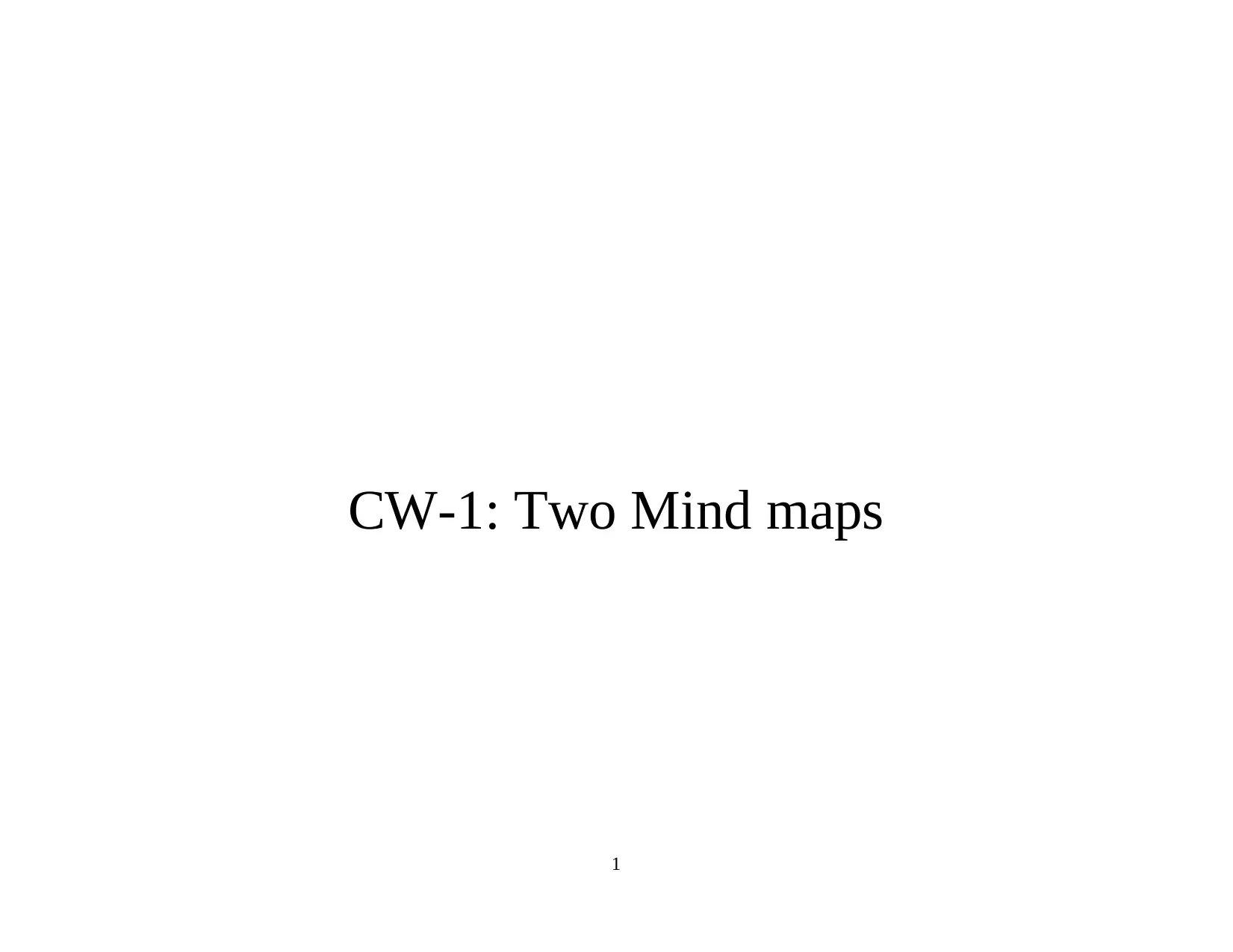
CW-1: Two Mind maps
1
1
Paraphrase This Document
Need a fresh take? Get an instant paraphrase of this document with our AI Paraphraser
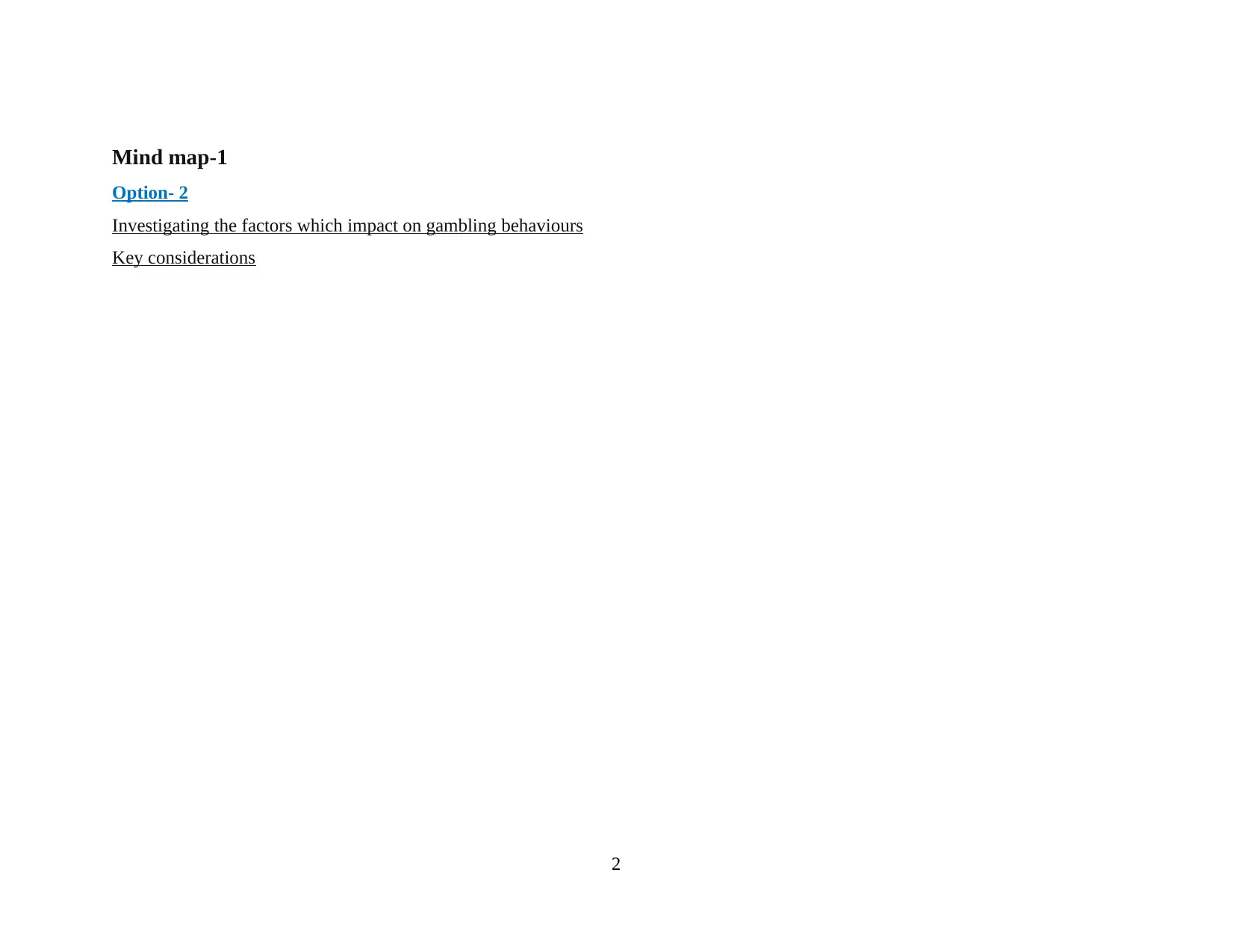
Mind map-1
Option- 2
Investigating the factors which impact on gambling behaviours
Key considerations
2
Option- 2
Investigating the factors which impact on gambling behaviours
Key considerations
2
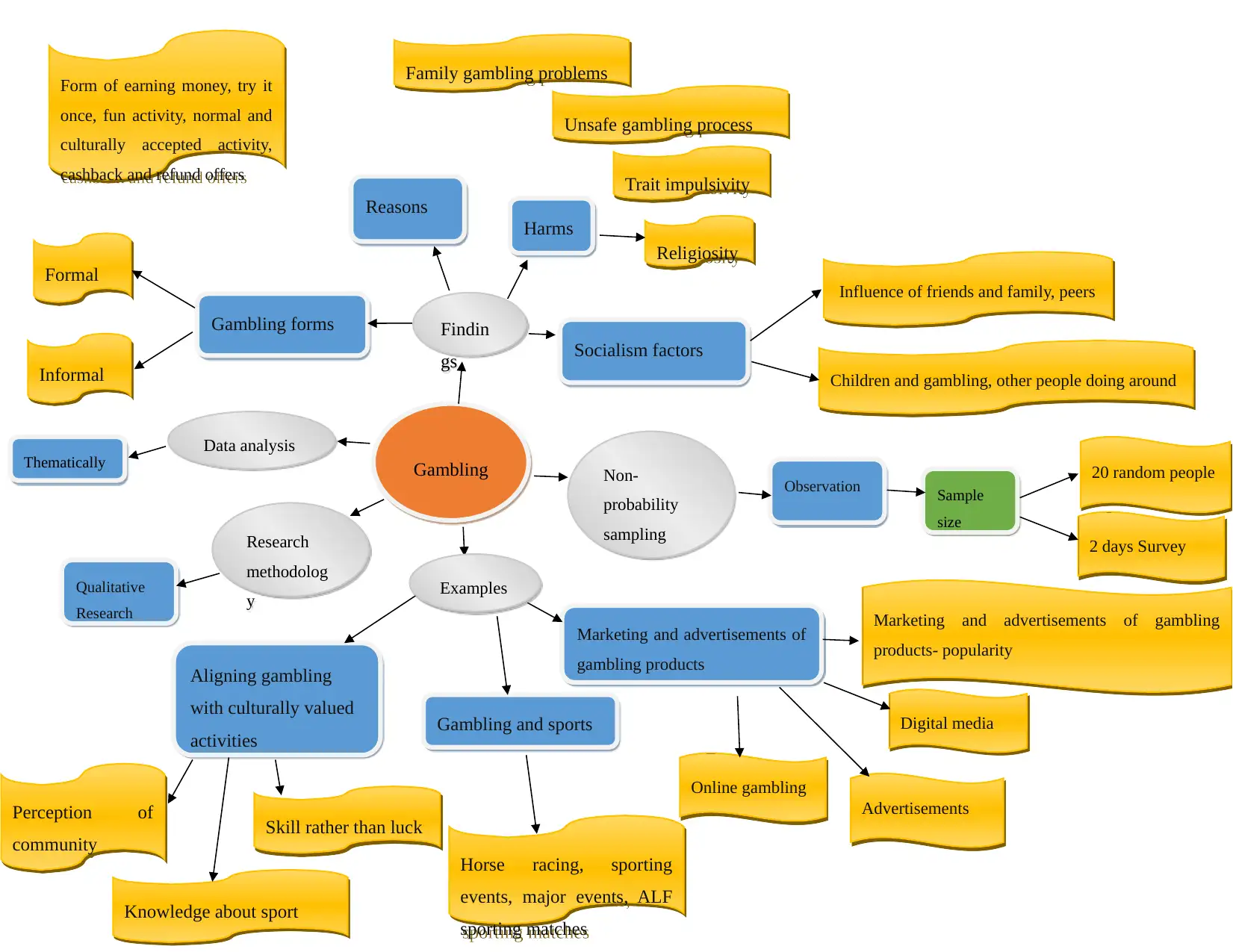
3
Gambling
Reasons
Harms
Socialism factors
Marketing and advertisements of
gambling products
Gambling and sports
Aligning gambling
with culturally valued
activities
Gambling forms
Influence of friends and family, peers
Unsafe gambling process
Horse racing, sporting
events, major events, ALF
sporting matches
Form of earning money, try it
once, fun activity, normal and
culturally accepted activity,
cashback and refund offers
Formal
Perception of
community
20 random people
Sample
size
Marketing and advertisements of gambling
products- popularity
Findin
gs
Research
methodolog
y Examples
Informal
Family gambling problems
Trait impulsivity
Religiosity
Children and gambling, other people doing around
2 days Survey
Skill rather than luck
Knowledge about sport
Qualitative
Research
Online gambling
Digital media
Advertisements
Data analysis
Thematically Non-
probability
sampling
Observation
Gambling
Reasons
Harms
Socialism factors
Marketing and advertisements of
gambling products
Gambling and sports
Aligning gambling
with culturally valued
activities
Gambling forms
Influence of friends and family, peers
Unsafe gambling process
Horse racing, sporting
events, major events, ALF
sporting matches
Form of earning money, try it
once, fun activity, normal and
culturally accepted activity,
cashback and refund offers
Formal
Perception of
community
20 random people
Sample
size
Marketing and advertisements of gambling
products- popularity
Findin
gs
Research
methodolog
y Examples
Informal
Family gambling problems
Trait impulsivity
Religiosity
Children and gambling, other people doing around
2 days Survey
Skill rather than luck
Knowledge about sport
Qualitative
Research
Online gambling
Digital media
Advertisements
Data analysis
Thematically Non-
probability
sampling
Observation
⊘ This is a preview!⊘
Do you want full access?
Subscribe today to unlock all pages.

Trusted by 1+ million students worldwide
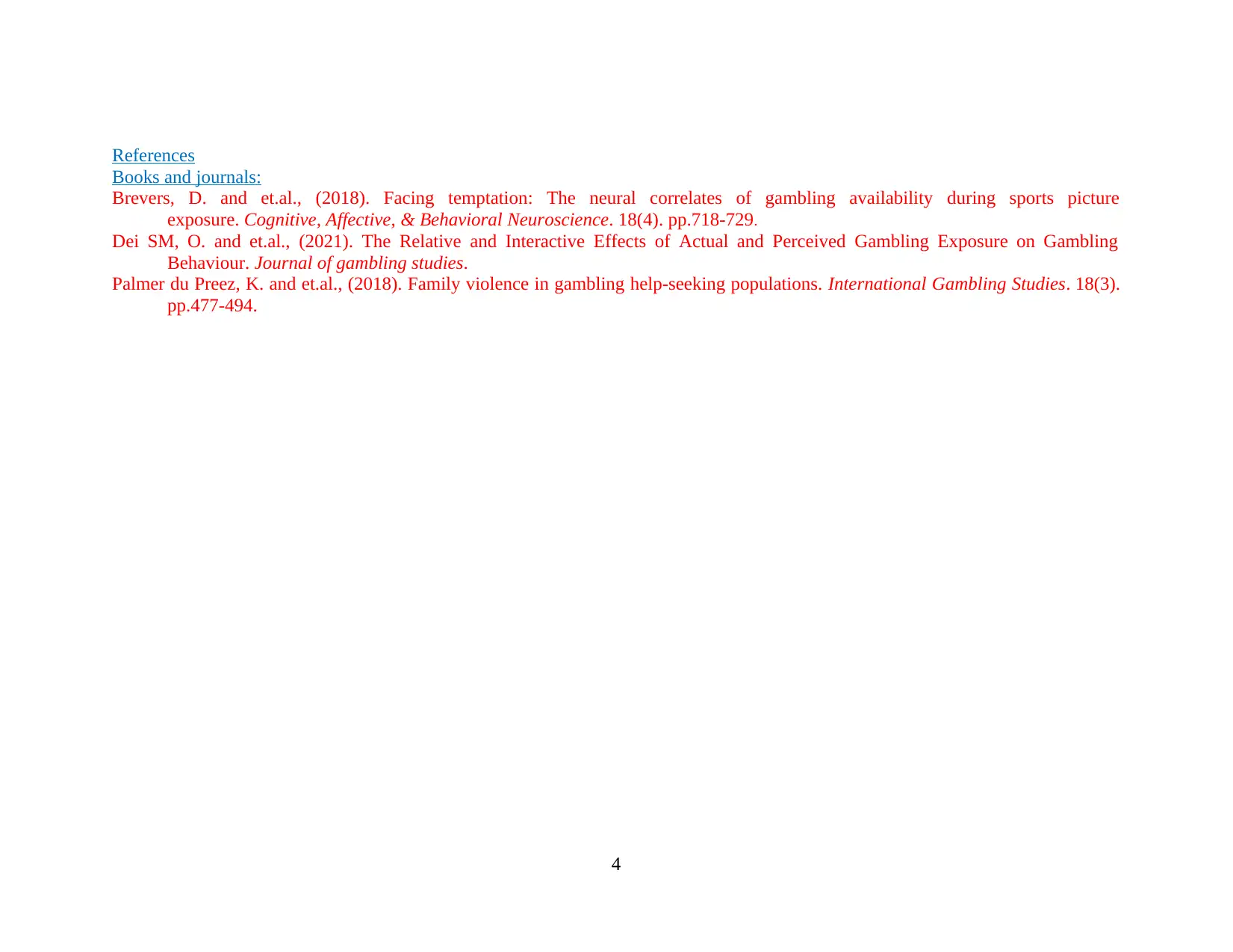
References
Books and journals:
Brevers, D. and et.al., (2018). Facing temptation: The neural correlates of gambling availability during sports picture
exposure. Cognitive, Affective, & Behavioral Neuroscience. 18(4). pp.718-729.
Dei SM, O. and et.al., (2021). The Relative and Interactive Effects of Actual and Perceived Gambling Exposure on Gambling
Behaviour. Journal of gambling studies.
Palmer du Preez, K. and et.al., (2018). Family violence in gambling help-seeking populations. International Gambling Studies. 18(3).
pp.477-494.
4
Books and journals:
Brevers, D. and et.al., (2018). Facing temptation: The neural correlates of gambling availability during sports picture
exposure. Cognitive, Affective, & Behavioral Neuroscience. 18(4). pp.718-729.
Dei SM, O. and et.al., (2021). The Relative and Interactive Effects of Actual and Perceived Gambling Exposure on Gambling
Behaviour. Journal of gambling studies.
Palmer du Preez, K. and et.al., (2018). Family violence in gambling help-seeking populations. International Gambling Studies. 18(3).
pp.477-494.
4
Paraphrase This Document
Need a fresh take? Get an instant paraphrase of this document with our AI Paraphraser
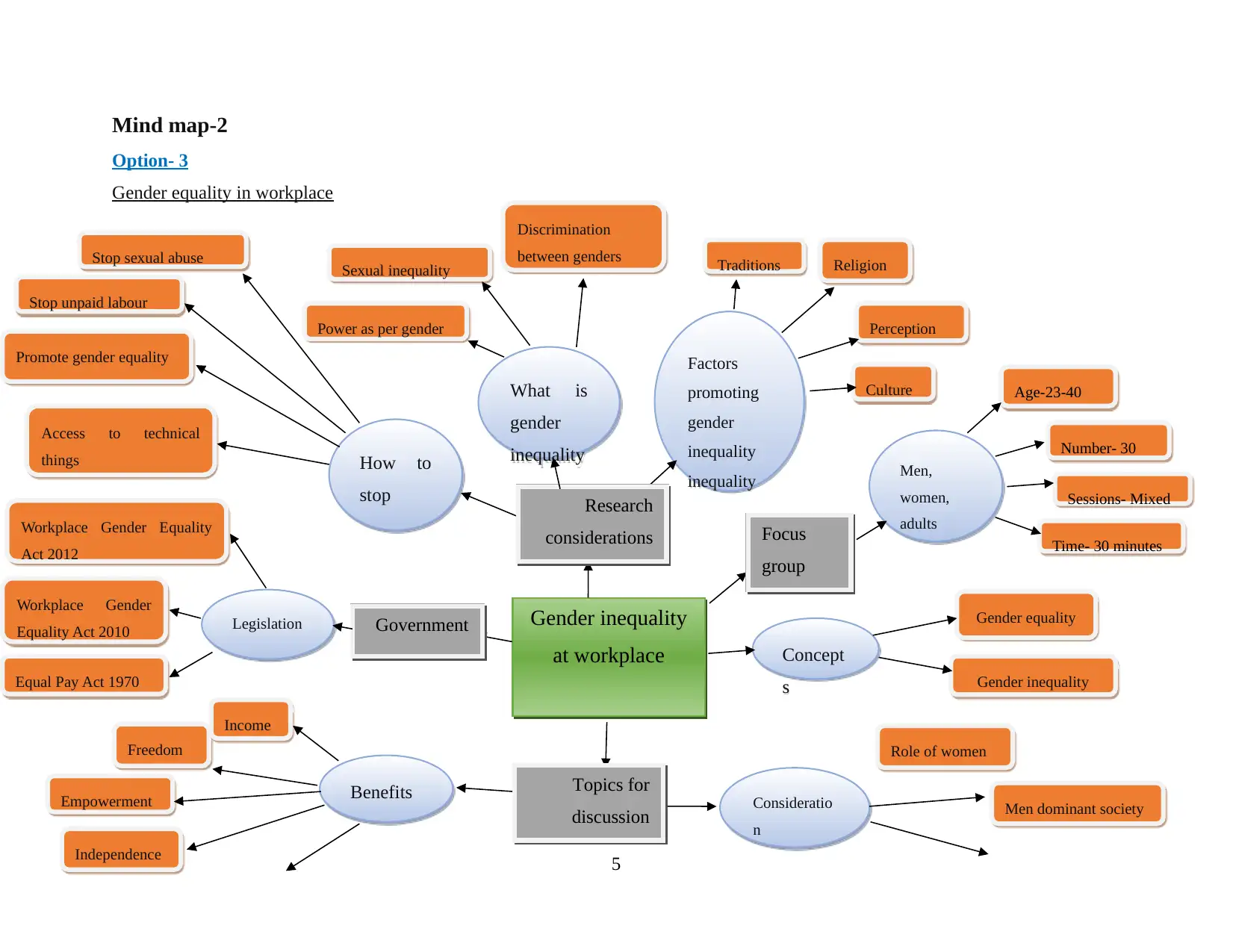
Mind map-2
Option- 3
Gender equality in workplace
5
Gender inequality
at workplace
What is
gender
inequality Men,
women,
adults
Concept
s
Consideratio
n
Benefits
How to
stop
Factors
promoting
gender
inequality
inequality
Legislation
Discrimination
between genders
Equal Pay Act 1970
Access to technical
things
Age-23-40
Gender equality
Role of women
Traditions
Focus
group
Research
considerations
Topics for
discussion
Government
Religion
Culture
PerceptionPower as per gender
Sexual inequality
Promote gender equality
Stop sexual abuse
Stop unpaid labour
Gender inequality
Number- 30
Sessions- Mixed
Time- 30 minutes
Freedom
Income
Empowerment
Independence
Men dominant society
Workplace Gender
Equality Act 2010
Workplace Gender Equality
Act 2012
Option- 3
Gender equality in workplace
5
Gender inequality
at workplace
What is
gender
inequality Men,
women,
adults
Concept
s
Consideratio
n
Benefits
How to
stop
Factors
promoting
gender
inequality
inequality
Legislation
Discrimination
between genders
Equal Pay Act 1970
Access to technical
things
Age-23-40
Gender equality
Role of women
Traditions
Focus
group
Research
considerations
Topics for
discussion
Government
Religion
Culture
PerceptionPower as per gender
Sexual inequality
Promote gender equality
Stop sexual abuse
Stop unpaid labour
Gender inequality
Number- 30
Sessions- Mixed
Time- 30 minutes
Freedom
Income
Empowerment
Independence
Men dominant society
Workplace Gender
Equality Act 2010
Workplace Gender Equality
Act 2012
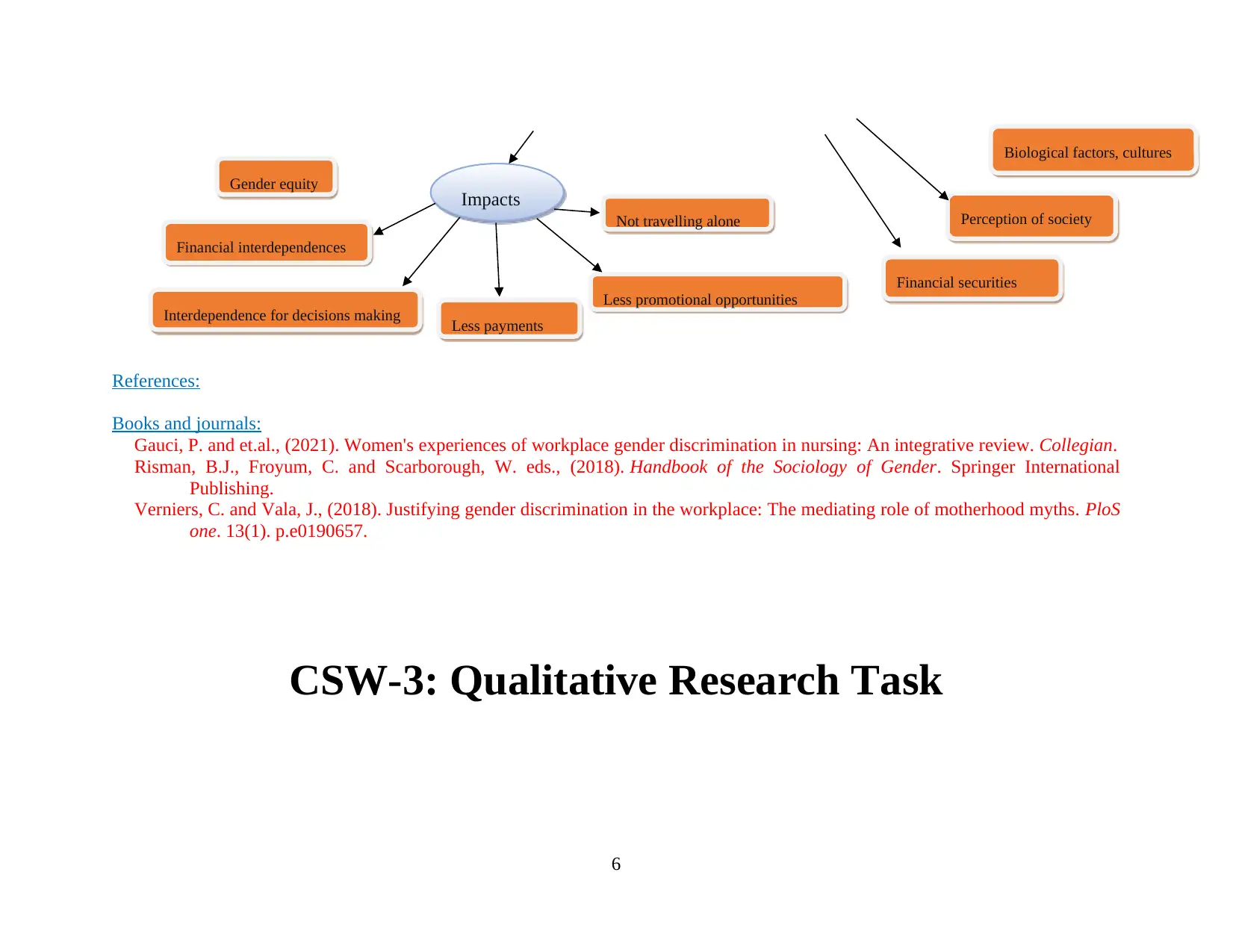
References:
Books and journals:
Gauci, P. and et.al., (2021). Women's experiences of workplace gender discrimination in nursing: An integrative review. Collegian.
Risman, B.J., Froyum, C. and Scarborough, W. eds., (2018). Handbook of the Sociology of Gender. Springer International
Publishing.
Verniers, C. and Vala, J., (2018). Justifying gender discrimination in the workplace: The mediating role of motherhood myths. PloS
one. 13(1). p.e0190657.
CSW-3: Qualitative Research Task
6
Impacts
Gender equity
Less payments
Financial securities
Perception of society
Biological factors, cultures
Not travelling alone
Interdependence for decisions making
Financial interdependences
Less promotional opportunities
Books and journals:
Gauci, P. and et.al., (2021). Women's experiences of workplace gender discrimination in nursing: An integrative review. Collegian.
Risman, B.J., Froyum, C. and Scarborough, W. eds., (2018). Handbook of the Sociology of Gender. Springer International
Publishing.
Verniers, C. and Vala, J., (2018). Justifying gender discrimination in the workplace: The mediating role of motherhood myths. PloS
one. 13(1). p.e0190657.
CSW-3: Qualitative Research Task
6
Impacts
Gender equity
Less payments
Financial securities
Perception of society
Biological factors, cultures
Not travelling alone
Interdependence for decisions making
Financial interdependences
Less promotional opportunities
⊘ This is a preview!⊘
Do you want full access?
Subscribe today to unlock all pages.

Trusted by 1+ million students worldwide

7
Paraphrase This Document
Need a fresh take? Get an instant paraphrase of this document with our AI Paraphraser
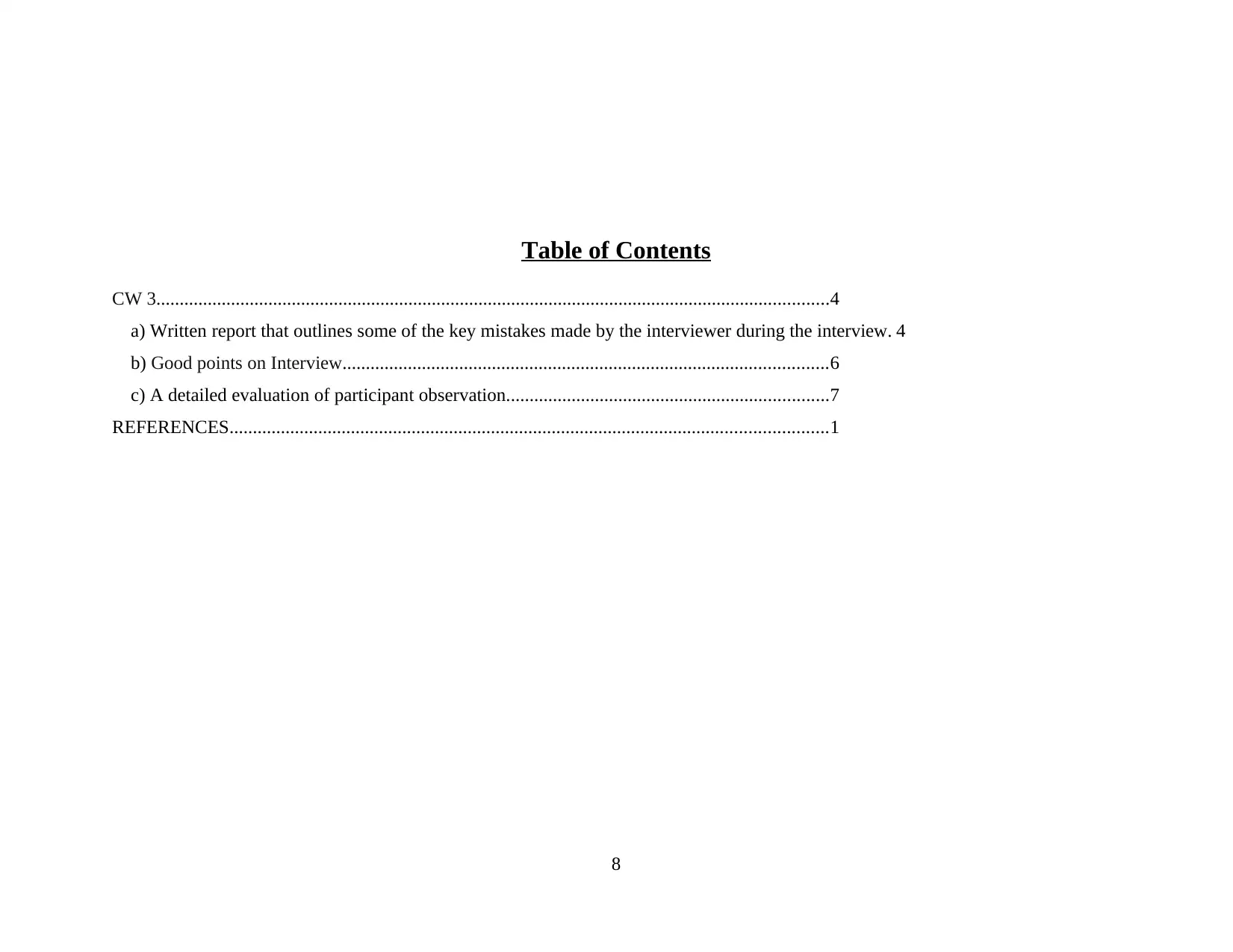
Table of Contents
CW 3................................................................................................................................................4
a) Written report that outlines some of the key mistakes made by the interviewer during the interview. 4
b) Good points on Interview........................................................................................................6
c) A detailed evaluation of participant observation.....................................................................7
REFERENCES................................................................................................................................1
8
CW 3................................................................................................................................................4
a) Written report that outlines some of the key mistakes made by the interviewer during the interview. 4
b) Good points on Interview........................................................................................................6
c) A detailed evaluation of participant observation.....................................................................7
REFERENCES................................................................................................................................1
8
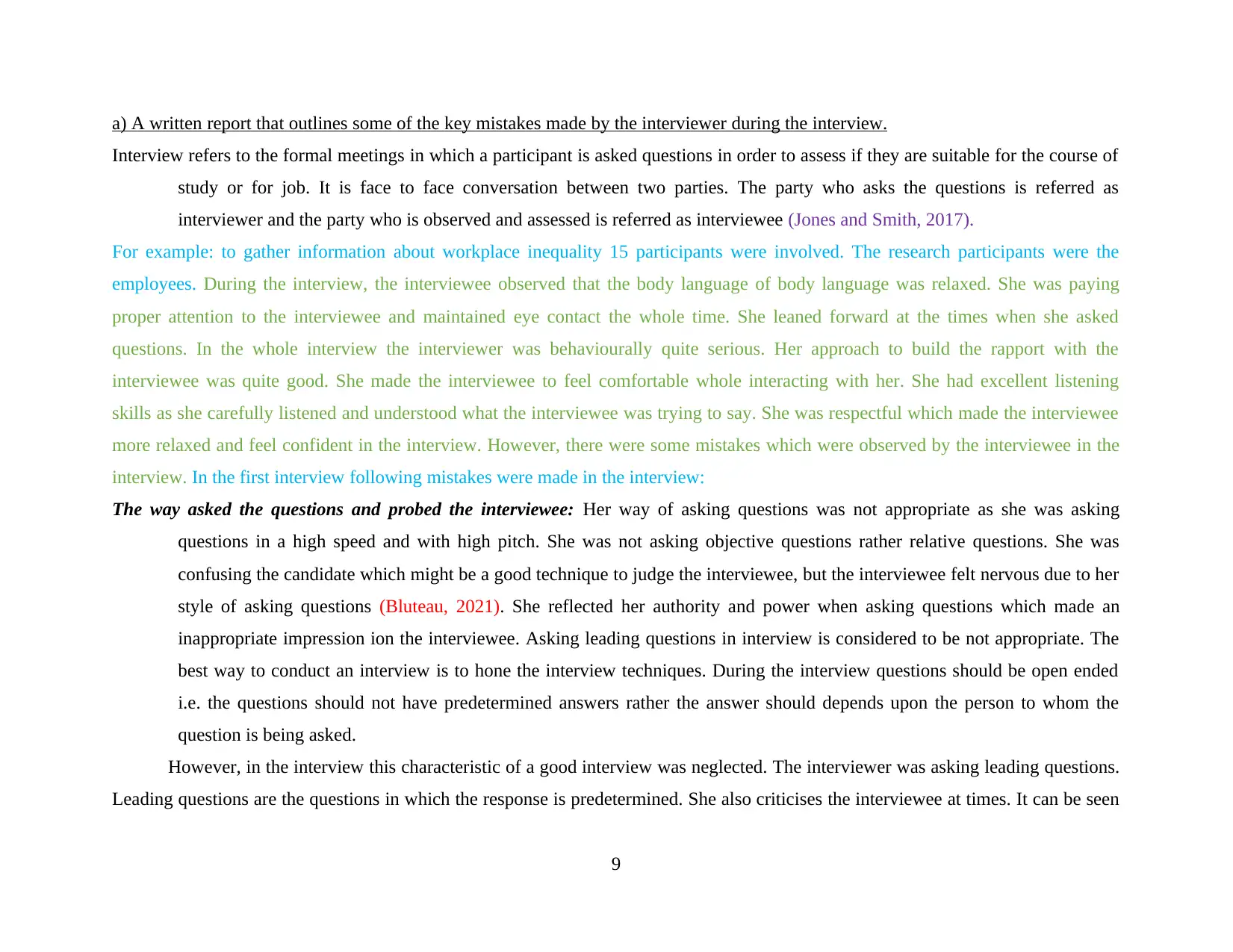
a) A written report that outlines some of the key mistakes made by the interviewer during the interview.
Interview refers to the formal meetings in which a participant is asked questions in order to assess if they are suitable for the course of
study or for job. It is face to face conversation between two parties. The party who asks the questions is referred as
interviewer and the party who is observed and assessed is referred as interviewee (Jones and Smith, 2017).
For example: to gather information about workplace inequality 15 participants were involved. The research participants were the
employees. During the interview, the interviewee observed that the body language of body language was relaxed. She was paying
proper attention to the interviewee and maintained eye contact the whole time. She leaned forward at the times when she asked
questions. In the whole interview the interviewer was behaviourally quite serious. Her approach to build the rapport with the
interviewee was quite good. She made the interviewee to feel comfortable whole interacting with her. She had excellent listening
skills as she carefully listened and understood what the interviewee was trying to say. She was respectful which made the interviewee
more relaxed and feel confident in the interview. However, there were some mistakes which were observed by the interviewee in the
interview. In the first interview following mistakes were made in the interview:
The way asked the questions and probed the interviewee: Her way of asking questions was not appropriate as she was asking
questions in a high speed and with high pitch. She was not asking objective questions rather relative questions. She was
confusing the candidate which might be a good technique to judge the interviewee, but the interviewee felt nervous due to her
style of asking questions (Bluteau, 2021). She reflected her authority and power when asking questions which made an
inappropriate impression ion the interviewee. Asking leading questions in interview is considered to be not appropriate. The
best way to conduct an interview is to hone the interview techniques. During the interview questions should be open ended
i.e. the questions should not have predetermined answers rather the answer should depends upon the person to whom the
question is being asked.
However, in the interview this characteristic of a good interview was neglected. The interviewer was asking leading questions.
Leading questions are the questions in which the response is predetermined. She also criticises the interviewee at times. It can be seen
9
Interview refers to the formal meetings in which a participant is asked questions in order to assess if they are suitable for the course of
study or for job. It is face to face conversation between two parties. The party who asks the questions is referred as
interviewer and the party who is observed and assessed is referred as interviewee (Jones and Smith, 2017).
For example: to gather information about workplace inequality 15 participants were involved. The research participants were the
employees. During the interview, the interviewee observed that the body language of body language was relaxed. She was paying
proper attention to the interviewee and maintained eye contact the whole time. She leaned forward at the times when she asked
questions. In the whole interview the interviewer was behaviourally quite serious. Her approach to build the rapport with the
interviewee was quite good. She made the interviewee to feel comfortable whole interacting with her. She had excellent listening
skills as she carefully listened and understood what the interviewee was trying to say. She was respectful which made the interviewee
more relaxed and feel confident in the interview. However, there were some mistakes which were observed by the interviewee in the
interview. In the first interview following mistakes were made in the interview:
The way asked the questions and probed the interviewee: Her way of asking questions was not appropriate as she was asking
questions in a high speed and with high pitch. She was not asking objective questions rather relative questions. She was
confusing the candidate which might be a good technique to judge the interviewee, but the interviewee felt nervous due to her
style of asking questions (Bluteau, 2021). She reflected her authority and power when asking questions which made an
inappropriate impression ion the interviewee. Asking leading questions in interview is considered to be not appropriate. The
best way to conduct an interview is to hone the interview techniques. During the interview questions should be open ended
i.e. the questions should not have predetermined answers rather the answer should depends upon the person to whom the
question is being asked.
However, in the interview this characteristic of a good interview was neglected. The interviewer was asking leading questions.
Leading questions are the questions in which the response is predetermined. She also criticises the interviewee at times. It can be seen
9
⊘ This is a preview!⊘
Do you want full access?
Subscribe today to unlock all pages.

Trusted by 1+ million students worldwide
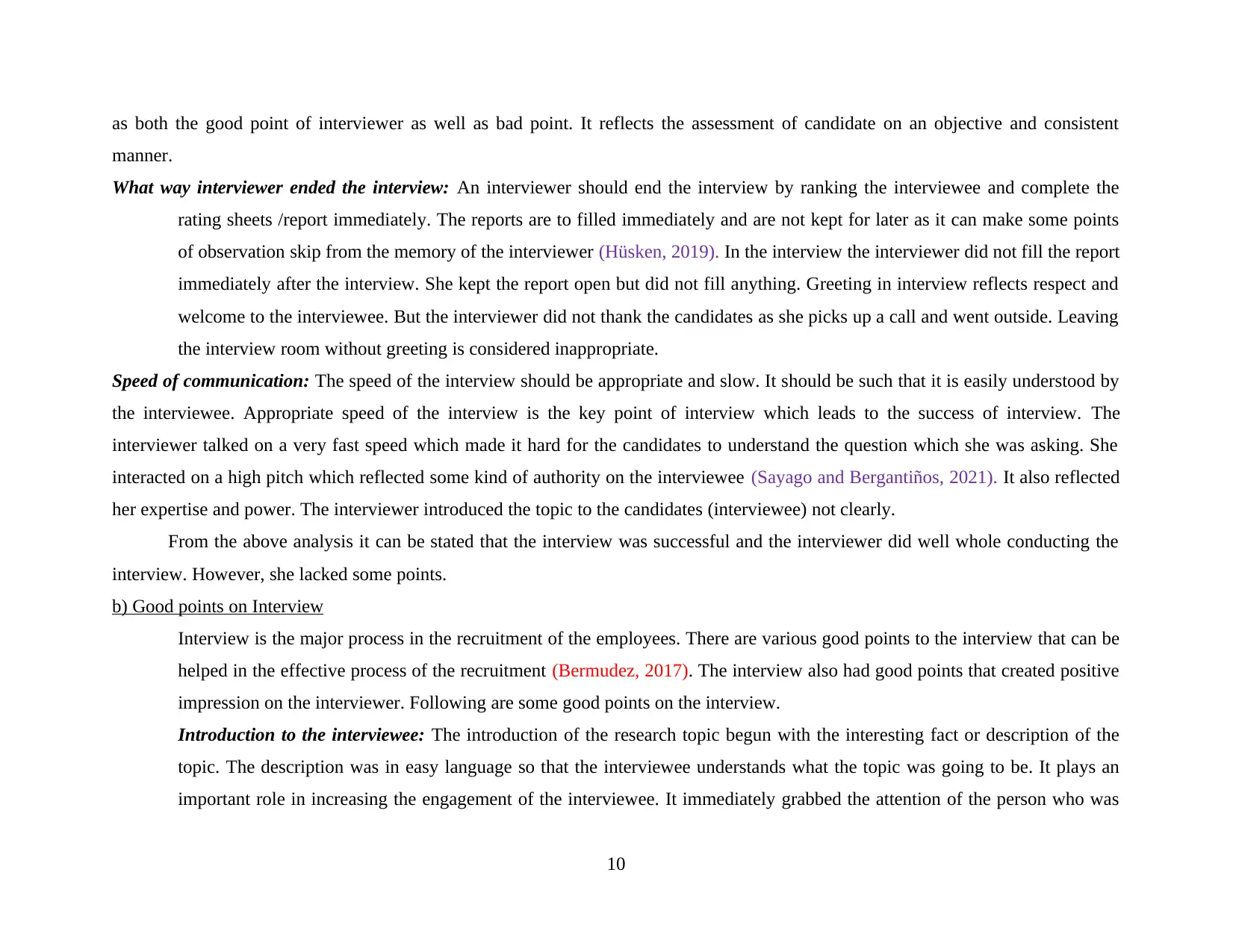
as both the good point of interviewer as well as bad point. It reflects the assessment of candidate on an objective and consistent
manner.
What way interviewer ended the interview: An interviewer should end the interview by ranking the interviewee and complete the
rating sheets /report immediately. The reports are to filled immediately and are not kept for later as it can make some points
of observation skip from the memory of the interviewer (Hüsken, 2019). In the interview the interviewer did not fill the report
immediately after the interview. She kept the report open but did not fill anything. Greeting in interview reflects respect and
welcome to the interviewee. But the interviewer did not thank the candidates as she picks up a call and went outside. Leaving
the interview room without greeting is considered inappropriate.
Speed of communication: The speed of the interview should be appropriate and slow. It should be such that it is easily understood by
the interviewee. Appropriate speed of the interview is the key point of interview which leads to the success of interview. The
interviewer talked on a very fast speed which made it hard for the candidates to understand the question which she was asking. She
interacted on a high pitch which reflected some kind of authority on the interviewee (Sayago and Bergantiños, 2021). It also reflected
her expertise and power. The interviewer introduced the topic to the candidates (interviewee) not clearly.
From the above analysis it can be stated that the interview was successful and the interviewer did well whole conducting the
interview. However, she lacked some points.
b) Good points on Interview
Interview is the major process in the recruitment of the employees. There are various good points to the interview that can be
helped in the effective process of the recruitment (Bermudez, 2017). The interview also had good points that created positive
impression on the interviewer. Following are some good points on the interview.
Introduction to the interviewee: The introduction of the research topic begun with the interesting fact or description of the
topic. The description was in easy language so that the interviewee understands what the topic was going to be. It plays an
important role in increasing the engagement of the interviewee. It immediately grabbed the attention of the person who was
10
manner.
What way interviewer ended the interview: An interviewer should end the interview by ranking the interviewee and complete the
rating sheets /report immediately. The reports are to filled immediately and are not kept for later as it can make some points
of observation skip from the memory of the interviewer (Hüsken, 2019). In the interview the interviewer did not fill the report
immediately after the interview. She kept the report open but did not fill anything. Greeting in interview reflects respect and
welcome to the interviewee. But the interviewer did not thank the candidates as she picks up a call and went outside. Leaving
the interview room without greeting is considered inappropriate.
Speed of communication: The speed of the interview should be appropriate and slow. It should be such that it is easily understood by
the interviewee. Appropriate speed of the interview is the key point of interview which leads to the success of interview. The
interviewer talked on a very fast speed which made it hard for the candidates to understand the question which she was asking. She
interacted on a high pitch which reflected some kind of authority on the interviewee (Sayago and Bergantiños, 2021). It also reflected
her expertise and power. The interviewer introduced the topic to the candidates (interviewee) not clearly.
From the above analysis it can be stated that the interview was successful and the interviewer did well whole conducting the
interview. However, she lacked some points.
b) Good points on Interview
Interview is the major process in the recruitment of the employees. There are various good points to the interview that can be
helped in the effective process of the recruitment (Bermudez, 2017). The interview also had good points that created positive
impression on the interviewer. Following are some good points on the interview.
Introduction to the interviewee: The introduction of the research topic begun with the interesting fact or description of the
topic. The description was in easy language so that the interviewee understands what the topic was going to be. It plays an
important role in increasing the engagement of the interviewee. It immediately grabbed the attention of the person who was
10
Paraphrase This Document
Need a fresh take? Get an instant paraphrase of this document with our AI Paraphraser
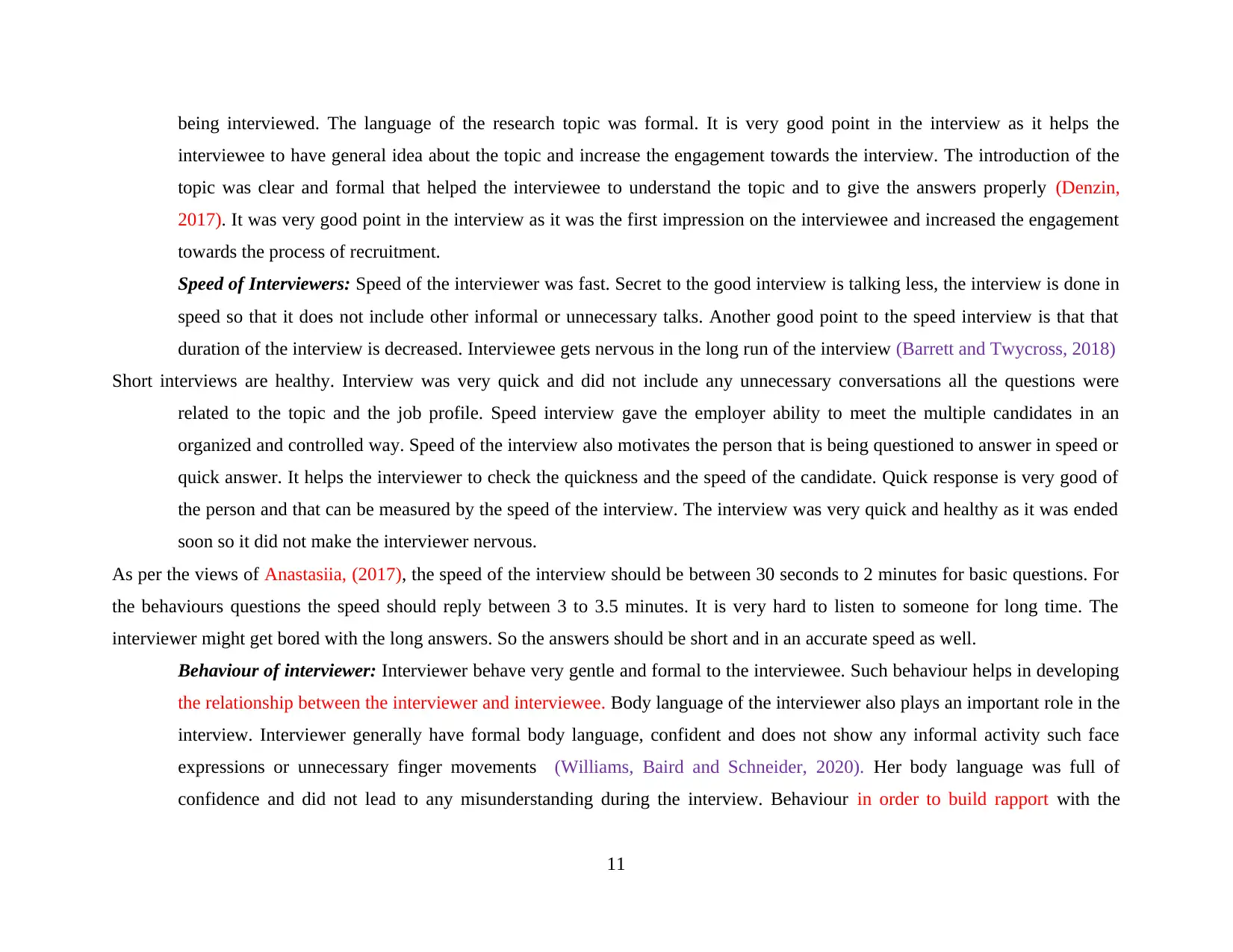
being interviewed. The language of the research topic was formal. It is very good point in the interview as it helps the
interviewee to have general idea about the topic and increase the engagement towards the interview. The introduction of the
topic was clear and formal that helped the interviewee to understand the topic and to give the answers properly (Denzin,
2017). It was very good point in the interview as it was the first impression on the interviewee and increased the engagement
towards the process of recruitment.
Speed of Interviewers: Speed of the interviewer was fast. Secret to the good interview is talking less, the interview is done in
speed so that it does not include other informal or unnecessary talks. Another good point to the speed interview is that that
duration of the interview is decreased. Interviewee gets nervous in the long run of the interview (Barrett and Twycross, 2018)
Short interviews are healthy. Interview was very quick and did not include any unnecessary conversations all the questions were
related to the topic and the job profile. Speed interview gave the employer ability to meet the multiple candidates in an
organized and controlled way. Speed of the interview also motivates the person that is being questioned to answer in speed or
quick answer. It helps the interviewer to check the quickness and the speed of the candidate. Quick response is very good of
the person and that can be measured by the speed of the interview. The interview was very quick and healthy as it was ended
soon so it did not make the interviewer nervous.
As per the views of Anastasiia, (2017), the speed of the interview should be between 30 seconds to 2 minutes for basic questions. For
the behaviours questions the speed should reply between 3 to 3.5 minutes. It is very hard to listen to someone for long time. The
interviewer might get bored with the long answers. So the answers should be short and in an accurate speed as well.
Behaviour of interviewer: Interviewer behave very gentle and formal to the interviewee. Such behaviour helps in developing
the relationship between the interviewer and interviewee. Body language of the interviewer also plays an important role in the
interview. Interviewer generally have formal body language, confident and does not show any informal activity such face
expressions or unnecessary finger movements (Williams, Baird and Schneider, 2020). Her body language was full of
confidence and did not lead to any misunderstanding during the interview. Behaviour in order to build rapport with the
11
interviewee to have general idea about the topic and increase the engagement towards the interview. The introduction of the
topic was clear and formal that helped the interviewee to understand the topic and to give the answers properly (Denzin,
2017). It was very good point in the interview as it was the first impression on the interviewee and increased the engagement
towards the process of recruitment.
Speed of Interviewers: Speed of the interviewer was fast. Secret to the good interview is talking less, the interview is done in
speed so that it does not include other informal or unnecessary talks. Another good point to the speed interview is that that
duration of the interview is decreased. Interviewee gets nervous in the long run of the interview (Barrett and Twycross, 2018)
Short interviews are healthy. Interview was very quick and did not include any unnecessary conversations all the questions were
related to the topic and the job profile. Speed interview gave the employer ability to meet the multiple candidates in an
organized and controlled way. Speed of the interview also motivates the person that is being questioned to answer in speed or
quick answer. It helps the interviewer to check the quickness and the speed of the candidate. Quick response is very good of
the person and that can be measured by the speed of the interview. The interview was very quick and healthy as it was ended
soon so it did not make the interviewer nervous.
As per the views of Anastasiia, (2017), the speed of the interview should be between 30 seconds to 2 minutes for basic questions. For
the behaviours questions the speed should reply between 3 to 3.5 minutes. It is very hard to listen to someone for long time. The
interviewer might get bored with the long answers. So the answers should be short and in an accurate speed as well.
Behaviour of interviewer: Interviewer behave very gentle and formal to the interviewee. Such behaviour helps in developing
the relationship between the interviewer and interviewee. Body language of the interviewer also plays an important role in the
interview. Interviewer generally have formal body language, confident and does not show any informal activity such face
expressions or unnecessary finger movements (Williams, Baird and Schneider, 2020). Her body language was full of
confidence and did not lead to any misunderstanding during the interview. Behaviour in order to build rapport with the
11
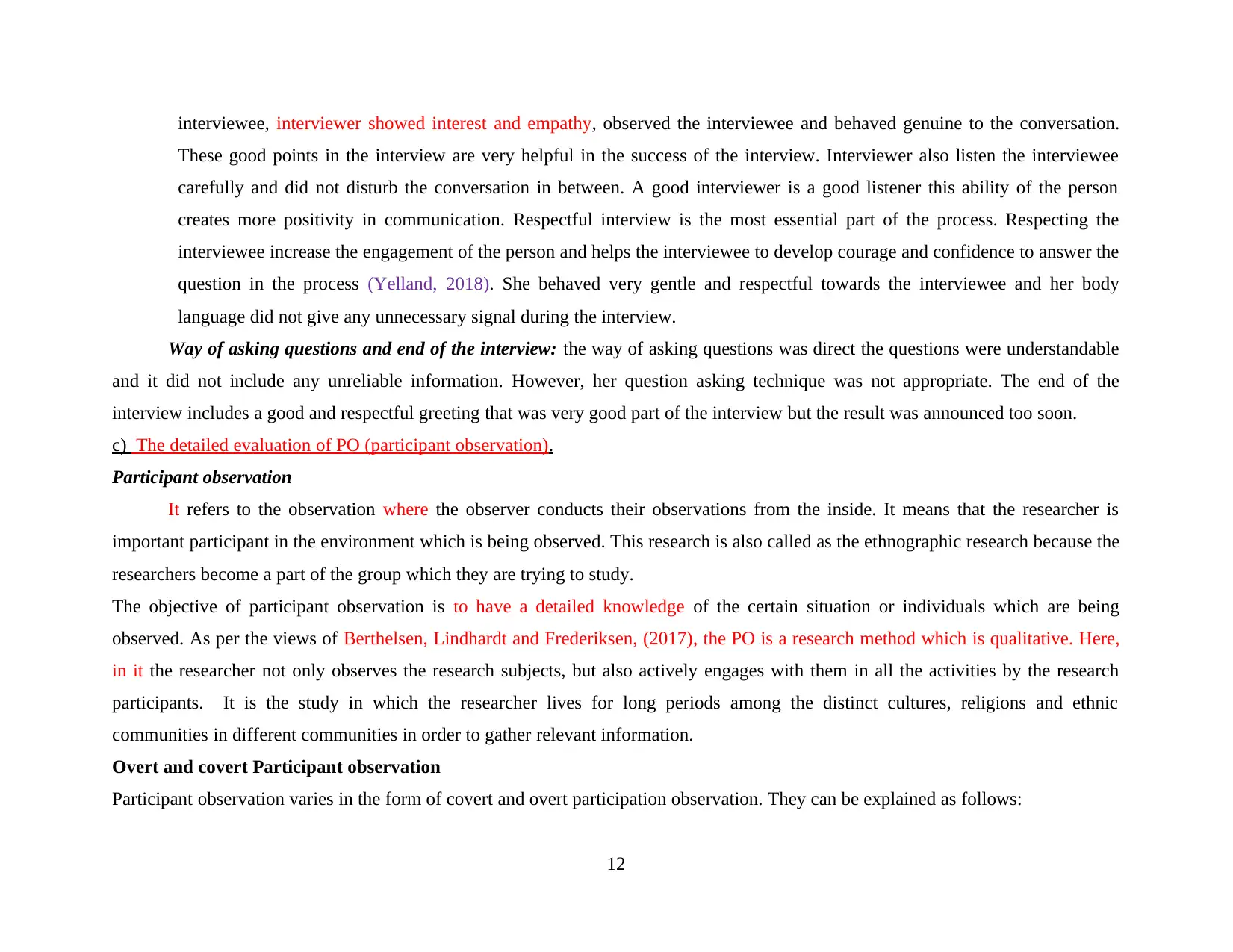
interviewee, interviewer showed interest and empathy, observed the interviewee and behaved genuine to the conversation.
These good points in the interview are very helpful in the success of the interview. Interviewer also listen the interviewee
carefully and did not disturb the conversation in between. A good interviewer is a good listener this ability of the person
creates more positivity in communication. Respectful interview is the most essential part of the process. Respecting the
interviewee increase the engagement of the person and helps the interviewee to develop courage and confidence to answer the
question in the process (Yelland, 2018). She behaved very gentle and respectful towards the interviewee and her body
language did not give any unnecessary signal during the interview.
Way of asking questions and end of the interview: the way of asking questions was direct the questions were understandable
and it did not include any unreliable information. However, her question asking technique was not appropriate. The end of the
interview includes a good and respectful greeting that was very good part of the interview but the result was announced too soon.
c) The detailed evaluation of PO (participant observation).
Participant observation
It refers to the observation where the observer conducts their observations from the inside. It means that the researcher is
important participant in the environment which is being observed. This research is also called as the ethnographic research because the
researchers become a part of the group which they are trying to study.
The objective of participant observation is to have a detailed knowledge of the certain situation or individuals which are being
observed. As per the views of Berthelsen, Lindhardt and Frederiksen, (2017), the PO is a research method which is qualitative. Here,
in it the researcher not only observes the research subjects, but also actively engages with them in all the activities by the research
participants. It is the study in which the researcher lives for long periods among the distinct cultures, religions and ethnic
communities in different communities in order to gather relevant information.
Overt and covert Participant observation
Participant observation varies in the form of covert and overt participation observation. They can be explained as follows:
12
These good points in the interview are very helpful in the success of the interview. Interviewer also listen the interviewee
carefully and did not disturb the conversation in between. A good interviewer is a good listener this ability of the person
creates more positivity in communication. Respectful interview is the most essential part of the process. Respecting the
interviewee increase the engagement of the person and helps the interviewee to develop courage and confidence to answer the
question in the process (Yelland, 2018). She behaved very gentle and respectful towards the interviewee and her body
language did not give any unnecessary signal during the interview.
Way of asking questions and end of the interview: the way of asking questions was direct the questions were understandable
and it did not include any unreliable information. However, her question asking technique was not appropriate. The end of the
interview includes a good and respectful greeting that was very good part of the interview but the result was announced too soon.
c) The detailed evaluation of PO (participant observation).
Participant observation
It refers to the observation where the observer conducts their observations from the inside. It means that the researcher is
important participant in the environment which is being observed. This research is also called as the ethnographic research because the
researchers become a part of the group which they are trying to study.
The objective of participant observation is to have a detailed knowledge of the certain situation or individuals which are being
observed. As per the views of Berthelsen, Lindhardt and Frederiksen, (2017), the PO is a research method which is qualitative. Here,
in it the researcher not only observes the research subjects, but also actively engages with them in all the activities by the research
participants. It is the study in which the researcher lives for long periods among the distinct cultures, religions and ethnic
communities in different communities in order to gather relevant information.
Overt and covert Participant observation
Participant observation varies in the form of covert and overt participation observation. They can be explained as follows:
12
⊘ This is a preview!⊘
Do you want full access?
Subscribe today to unlock all pages.

Trusted by 1+ million students worldwide
1 out of 17
Related Documents
Your All-in-One AI-Powered Toolkit for Academic Success.
+13062052269
info@desklib.com
Available 24*7 on WhatsApp / Email
![[object Object]](/_next/static/media/star-bottom.7253800d.svg)
Unlock your academic potential
Copyright © 2020–2025 A2Z Services. All Rights Reserved. Developed and managed by ZUCOL.





